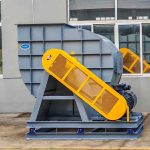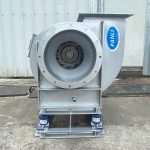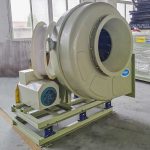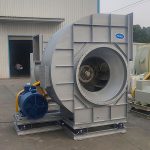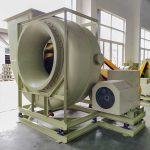Ventilador de plástico reforçado com fibra de vidro antiestático
Ventilador de plástico reforçado com fibra de vidro antiestático
The anti-static FRP fan is mainly composed of impeller, housing, air intake, motor, bearing seat, belt, pulley, shock absorber and other configuration. The fan housing and inlet bell are treated with anti-static, and the performance of the fan is tested. The vibration of the unit conforms to ISO2372 G4.5 grade specification.
Apresentação do produto
The anti-static FRP fan is mainly composed of impeller, housing, air intake, motor, bearing seat, belt, pulley, shock absorber and other configuration. The fan housing and inlet bell are treated with anti-static, and the performance of the fan is tested. The vibration of the unit conforms to ISO2372 G4.5 grade specification.
An Anti-Static Glass Fiber Reinforced Plastic Fan (FRP Fan) is an industrial ventilation solution developed to safely handle static-sensitive or combustible gases in corrosive environments. Conventional FRP fans, while corrosion-resistant, can accumulate static electricity during operation—posing ignition risks. This model resolves that issue through anti-static conductive materials and grounding systems, making it suitable for chemical laboratories, electronics factories, coating lines, and solvent-handling facilities.
The fan body, including the impeller and volute, is manufactured from conductive fiberglass-reinforced plastic incorporating carbon fiber or conductive resin compounds. This ensures a controlled surface resistivity that allows static charges to dissipate safely to ground. The fan operates as a centrifugal type, generating pressure by accelerating air radially outward from the impeller. The impeller is designed with backward-curved blades for high efficiency, stable airflow, and reduced turbulence.
All structural components are non-sparking. The shaft and fasteners are stainless steel, while bearings are isolated from the airflow to avoid contamination. The motor can be explosion-proof or standard, depending on the installation zone classification. A grounding wire is connected directly to the fan frame to ensure complete electrostatic discharge safety. The internal surfaces of the FRP casing are polished smooth to reduce dust adhesion and maintain airflow efficiency.
Typical air performance includes air volumes from 800 m³/h to 60,000 m³/h and pressures between 400 and 3,500 Pa. The anti-static FRP fan is widely used in electronic component manufacturing, pharmaceutical cleanrooms, and solvent exhaust systems. Its combination of corrosion resistance, lightweight design, and static-dissipation capability makes it a key component in modern industrial air handling where both chemical safety and electrostatic control are essential.








